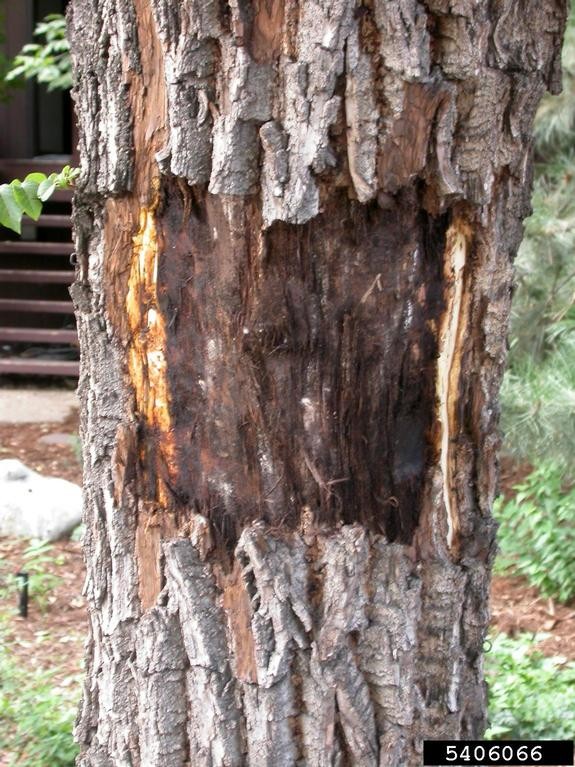Thousand Cankers Disease
In 2010, initial detections of a disease in Knox County, TN on black walnut raised concerns for the forest industry in Tennessee. Thousand Cankers Disease (TCD), caused by the fungus Geosmithia morbida, caused mortality in walnut trees, and spread to several neighboring counties.
Walnut trees are important because of their nut crop and the desired wood for lumber and veneer. While fewer detections of this disease have been found in more recent years, the information below includes details on the disease, its impact in Tennessee, and the recent end of the state quarantine for TCD.
TCD is a progressive disease that has been known to kill walnuts within two to three years after initial infection, although with milder infections, some trees were able to recover.

The walnut twig beetle (WTB) carries the spores of a disease-causing fungus, G. morbida, and tunnels into the trunks or branches of black walnuts. The combined activity of the fungus and the beetle lead to development of cankers, and with repeated attacks may eventually lead to tree mortality. The walnut twig beetle (Pityophthorus juglandis) is native to Arizona, California, and New Mexico and has more recently been detected in Colorado, Oregon, Idaho, and Washington. The native origin of TCD is unknown but the disease has been present in the western states since the late 90’s.
The visual symptoms of TCD are the “thousand” cankers that develop around each of the walnut twig beetle galleries. The cankers are found just under the living bark and are dark in color and can be anywhere from a less than 1 inch to over 1 yard long. A shallow tunnel made by the walnut twig beetle will typically be at the center of the canker. The walnut twig beetle itself is small (1/16th inch long) and reddish brown. The larvae are white, C shaped and can be found under the bark in the phloem of the tree.
A black walnut tree can be infected for several years before showing signs of disease. The first symptom is typically flagging (leaves wilting and yellowing in mid-summer). The crown then begins to thin due to twig and branch dieback. Epicormic branches (sprouts along the lower trunk and base) may appear as well as “thousands” of cankers under the bark. Once a walnut tree begins to show symptoms, the tree rapidly declines and will die within a few years. The fungus requires multiple introductions by the beetle in order to infect and kill the walnut tree. Because few if any walnut twig beetles have been caught in survey traps in recent years, the number of trees showing severe cankers has declined. Trees with only a few cankers have been shown to recover.
The fungus that causes TCD, Geosmithia morbida, can be confirmed by culturing on agar media and more recent research has identified potential methods for molecular identification of the disease to confirm samples. Presence of cankers or the walnut twig beetle is typically indicative of this disease, and samples collected from the infected tree could be tested to confirm the presence of TCD.
Upon discovery in Knoxville in July 2010, several counties were placed under state government regulation. As new counties detected the disease, those counties and counties adjacent to new detections were added to the state quarantine. This quarantine had limited the movement of any walnut products including logs, lumber, firewood, and mulch.
After several years of intensive surveys for this disease, and fewer detections being made even in counties previously confirmed positive for TCD, the state quarantine was lifted in 2021. While no detections of this disease have been reported in recent years, continued awareness of TCD and its symptoms is useful to continue to monitor black walnuts in Tennessee.
TCD County Infestation Map

Counties shown in blue had confirmed detections of thousand cankers disease, and during the period when the state quarantine was in place, a buffer of counties, shown in yellow, were quarantined and intensively surveyed to prevent the spread of TCD. After 2021, when the Tennessee state quarantine was lifted, these counties are no longer under TCD quarantine.
Maintaining healthy walnut trees is a good rule of thumb for managing TCD. Healthy trees are less susceptible to stressors and diseases and may have a better opportunity to recover from potential infection. Since black walnut trees produce edible nuts, chemical control options for TCD are limited, so promoting healthy trees is the most viable management strategy. Monitoring tree health, for walnuts and other trees, can also help identify potential insect or disease issues in forest woodlots and can allow proactive management of issues as they arise.
Although the state quarantine is no longer in effect, consider what wood material you are transporting, as movement of firewood and untreated wood products is the leading vector of a variety of insects and diseases in the United States.
What Can You Do?
Don’t Move Firewood! Firewood is a common transportation method for a variety of forest pests and pathogens, including TCD and WTB. Learn to recognize what the signs and symptoms are of this disease and contact your county agent, professional forester, or the Division of Forestry if you suspect your black walnut tree is infected and would like more information.
